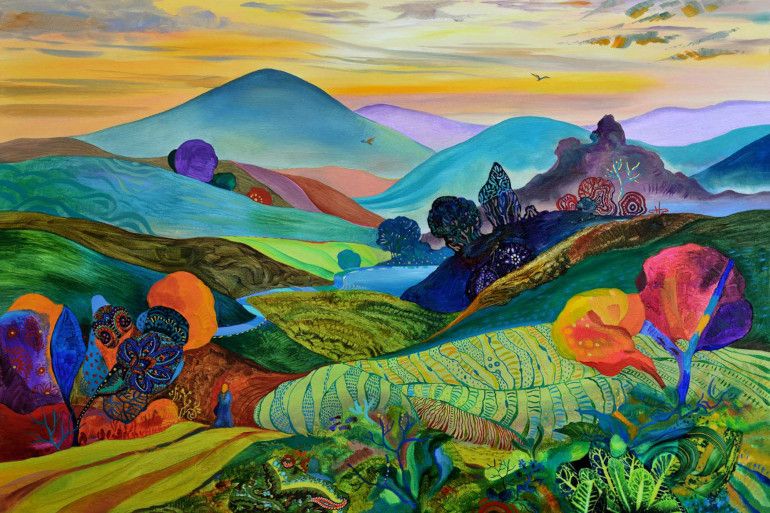Silvia Pavlova‘s exhibition in Gallery Vazrazdane
Written and photos by our media partner Highstreet.bg
“Bosom”, "The Old Fountain", "The Way of the River", "The Moon Tells", "The Silence of the Sunset", "Violet Time" - these are not titles of favorite fairy tales, but some of the names of the paintings in the captivating exhibition by Silvia Pavlova, presented by the Plovdiv Vazrazdane Gallery.
It is no coincidence that the curators Krassi and Sim Aleksievi invite this artist from Sofia for a special Christmas exhibition. Silvia is a sorcerer-creator and wizard-narrator. She is beauty, soul, and color explosion. She is magic, depth, and ethereality. She possesses the gift, the tenderness, and the strength. With her new exhibition "Roots", the artist presents to Plovdiv's audience her lyrical, vibrant and miraculous return to the source and her Bulgarian heritage.
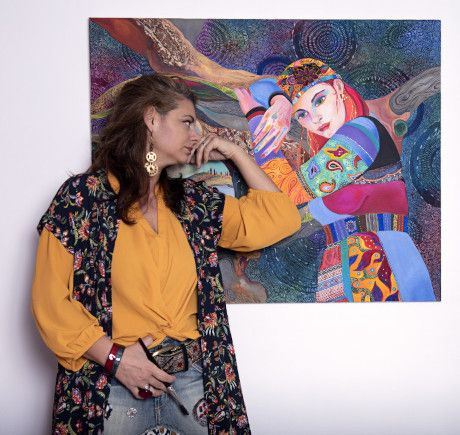
- Silvia, many young Bulgarian artists have a desire to sound contemporary and do everything possible to distance themselves from their roots. You dedicate an entire solo exhibition to your heritage. Why?
Roots are an emotional topic. For this reason, it seems to me that there are many people in Bulgaria who do not want to turn in this direction because their sentiment makes them weak. There are many reasons for this. It's not just about artists. There are people who want to run away from something their entire lives, to be different, to be elsewhere and they think that will make them happy and successful. The main problem, in my opinion, is the lack of respect. We don't respect ourselves, we don't respect the person next to us, we don't respect our parents, we don't respect authorities, but when we are there, in the other world, we will understand that "others" respect our roots much more than us and the added value we give to their society. You can be anyone and anywhere, but it's good to remember where you came from because it will really give you another worth and quality, especially when it comes to art. Above all, creators want to be free. To interpret what excites them. And what is "contemporary sound" is a very speculative topic. I can say that I consider myself a contemporary-sounding artist. I am excited about Africa and Asia and this is evident in my paintings, but there is always something from me and Bulgaria.
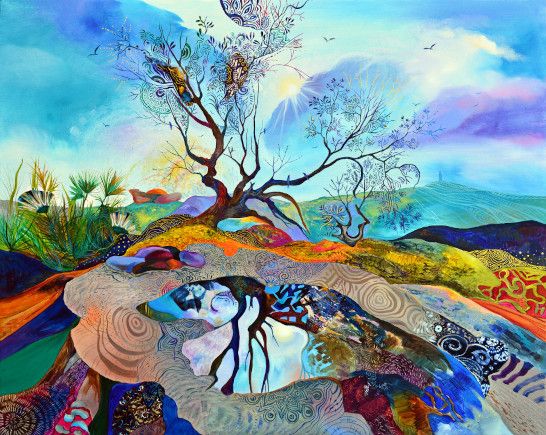 "Angel"
"Angel"
- In her book “The God’s mistress”, the Bulgarian author Rozmary De Meo writes: “Here, your soul has chosen our Bulgarian land. And it clung to it with one thing called Root. The root has various spurs - descends, folk, language, pains, joys - all left by those before you. They are in our fate. They will give you love and strength, and they will shake you sometimes…”[1]
Do your roots call you? Are they the secret of your creative female power? And do they “shake” you sometimes?
I believe that I have chosen where and with whom to be born, so I have never grumbled against my land and I did not want to live anywhere else. My roots are strong, our relationship is good, they call me, I answer the best way I can. Sometimes I get exhausted from the balance between the irrational and the everyday, but I always feel the love and support of the invisible. On my father’s side, we are 400 people line. My great-grandmother was a midwife, and the house she lived in burned down years ago on a rainy St. Nicholas Day. The strongest connection is through my grandfather on my mother’s side, with whom we were not so close during his lifetime. People called him the “Master” and was [sic] greatly respected by all whom he had helped. He is from Ponor Mountain[2]. There, in that mystique where the water gets lost in the ground, with the old Roman roads on the ridges, I love the most the hills and the river, I love the stone and I miss the house when I am in the city, as if I left a living person behind, waiting for me… I don’t know where my strength comes from and whether it is feminine or what it is, but I feel that the most important thing in my life is that once, as a child, a dear person taught me to love and accept.
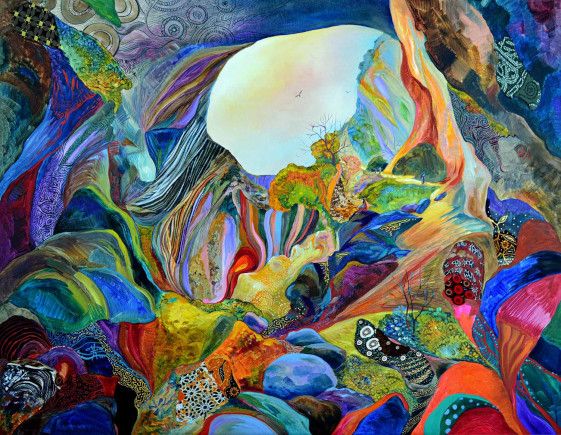 "Bosom"
"Bosom"
- What is the invisible thread that connects our souls to the roots? How does it become tangible in your paintings?
I have no idea how this happens. I can’t explain it, but I can feel it. I do not understand what happens by itself and which part I participate in. The process is deep to realize and I am nowhere. I know about the thread that somewhere there are past lives, childhood, memories, talent, God, and maybe intuition. I try to capture a moment, and it becomes an ambiance, a breath, infinity.
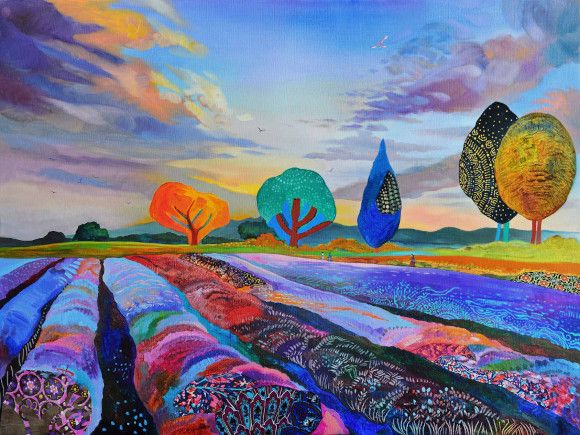 "Purple Time"
"Purple Time"
- Esotericism is present in our folklore and traditions. You don't just paint landscapes, you tell fairy tales! Is this your feeling for our land, the Bulgarian one? Is it magic, is it a mystery?
There is magic, there is power from the earth for anyone who wants to connect. And fairy tales are not just fairy tales. I wanted to make this exhibition only with landscapes because we are one with nature. I’ve always loved painting trees. I like to interpret the beauty of their crowns, but when winter comes I am amazed by the magical shapes of the trunks and branches. The tree is a symbol of the connection between Earth and Heaven. This relationship will always excite a person. The bridge between the Upper and the Lower Earth, life, death, and renewal. We are connected and God is in us. Water is also my main source of inspiration as a symbol of life, so my painting "The Old Fountain" can be called the fortress of life. Most of the landscapes are from my places, from the Iskar Gorge and the Etropole Balkans, but I have painted other unknown places that remind me of days gone by in which people can recognize their place.
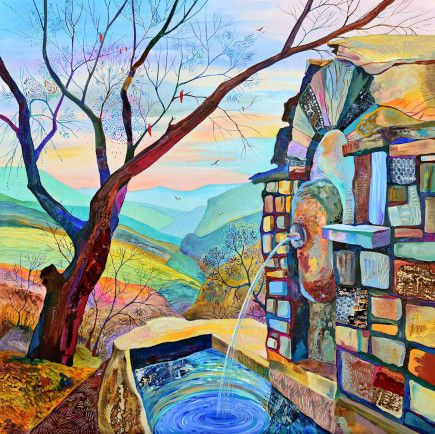 "The Old Fountain"
"The Old Fountain"
- Your technique is unique - you combine oil paints and textiles on canvas. How was it born and why do you like working with it?
Textiles are my great love. I like to paint on silk and combine fabrics. The pieces of fabric that I mount on the canvasses are the first step after composing the painting with a pencil. From them, the painting begins to form its shape, color, the palette and whether the landscape will be more realistic, decorative, or abstract. I am excited by the symbiosis between these components and styles. I play with them and I am surprised by what happens. Textiles add value to paintings and make them more unique, at least because the pieces of fabric always run out and I can no longer find them. The fabrics I work with are all kinds, but I prefer cotton. They are from old clothes, lace, tablecloths, samples from manufacturers, and importers of fabrics. Sometimes I even buy new clothes from a shop window just to cut them afterward. I love the sound of scissors.
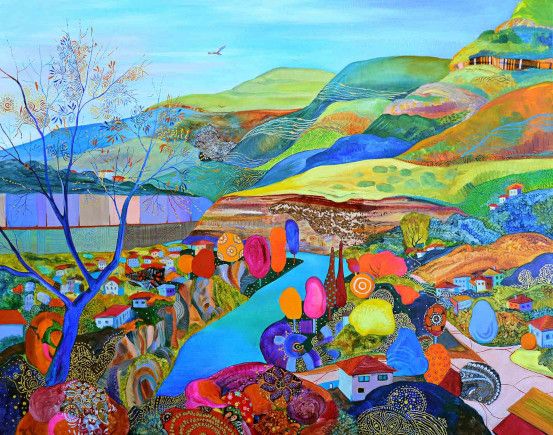 "The Way of the River"
"The Way of the River"
- You are a fiery woman and artist! What ignites you and what humbles you?
I have felt over the years that I have a specific creative cycle. A certain time in the rise and energy, then decline and again everything turns. I haven't learned to control it, I don't feel I can and I don't know if I should. When I'm into a spur, I paint until 3 am and get up in the morning with enthusiasm to continue, but in the next days I can't get out of bed. Otherwise, the initial answer to this question is very simple and banal. People who are close to me know that there is certain music that always shoots me like a spring and charges me immensely. And then songs, dances, tears and a lot of fire… Nature humbles me.
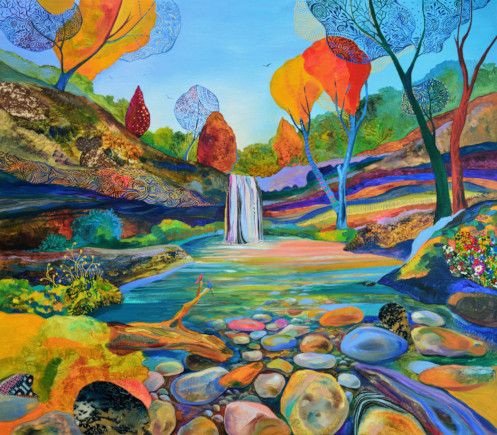
Silvia Pavlova was born in 1979. She lives and works in Sofia as a freelance artist. In 1998 she graduated from the National High School of Applied Arts “St. Luka” with a degree in textile and clothing technology. In 2006 she graduated from the New Bulgarian University in Sofia with a master’s degree in fine art and stage design. She has over 20 solo exhibitions. She has participated in over 30 collective exhibitions and plein airs in Bulgaria, Italy, Germany, Austria, the Fijian Islands, and Russia. She is the winner of numerous prestigious awards, and her paintings adorn private collections around the world.
Vazrazdane Gallery officially opened the exhibition on 14 December and the exhibition will be open for visitors until 24 January 2022. The works of art can be viewed virtually, on the website here and on the Facebook page of the gallery here.
[1] Unofficial translation.
[2] Мountain karst region in the Western Balkan mountains (Stara Planina, which means the old mountains), on the territory of Sofia region.
Open Bulgaria and Highstreet Magazine partner up to support creative expression, local talent, and knowledge to the people. All in support of our communities. Originally published on Highstreet.bg
